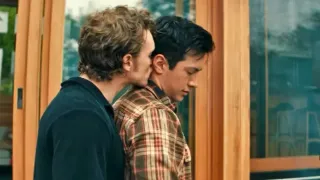September 27, 2024
Review: 'A Beautiful Noise' a Crowd Pleasing Night of Great Music
Will Demers READ TIME: 3 MIN.
Another national tour launches here in Providence at the historic Performing Arts Center, and this one is a crowd pleaser. "The Neil Diamond Musical A Beautiful Noise" takes its title from Diamond's 1976 album and tells the tale of his life through therapy sessions.
The aged Neil is played by Robert Westenberg. As he explores the his songs via a second-hand book of his lyrics with his doctor (Lisa Renee Pitts) we learn in flashback how these songs came to be.
"American Idol" winner Nick Fradiani reprises his recent Broadway role as the younger Diamond. It's easy to see why he helms the show: He balances the moods of the younger Diamond with an electric stage presence. The flashbacks reveal some incredibly flashy costumes and fantastic choreography, giving the audience a thrilling window to the past. In true jukebox musical fashion, Diamond's hits highlight the production – but Fradiani absolutely nails the singer's trademark vocal range.
As his love interest, Marcia, Hannah Jewel Kohn is a great match for Fradiani. Her upbeat cheerleader style is the balance for his broody early career, when Diamond wasn't sure he could even perform, let alone entertain the idea of being a superstar.
History tells us what would become of Neil, and Westenberg's quiet intensity reveals Diamond's inner turmoil as he plays guitar and writes songs for other bands. Meantime, as in life, the elder Diamond grapples with how Parkinson's Disease has robbed him of the ability to sing and perform.
But it's not all darkness and tragedy. Steven Hoggett's choreography dazzles, while David Rockwell's scenic design and Emilio Sosa's brilliant costume designs are outstanding. Michael Mayer's clever direction keeps the elder Diamond onstage throughout; although he seems to disappear whenever his younger counterpart performs a song or has some dialogue. It keeps the audience engaged even through the quieter times (of which there are very little).
Snappy lyrics, fun and familiar songs, and some truly heartfelt performances guarantee a satisfying night out. Even if you knew nothing about Neil before, this is a great way to spend a night enjoying some great music.
"The Neil Diamond Musical A Beautiful Noise" is running through September 28th at the Providence Performing Arts Center (PPAC) 220 Weybosset Street, Providence, Rhode Island 02903. For information or tickets call 401-421-2787 or visit www.ppacri.org.






